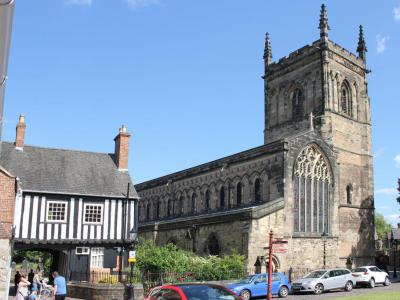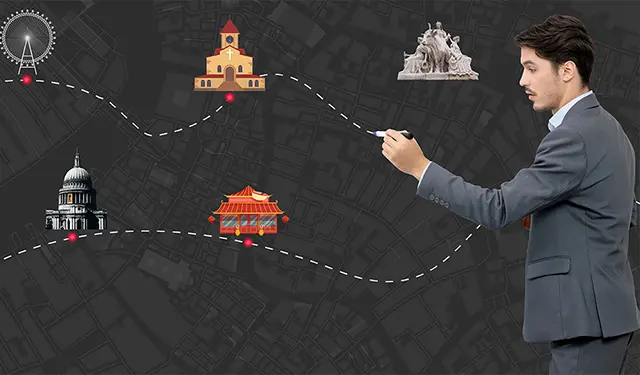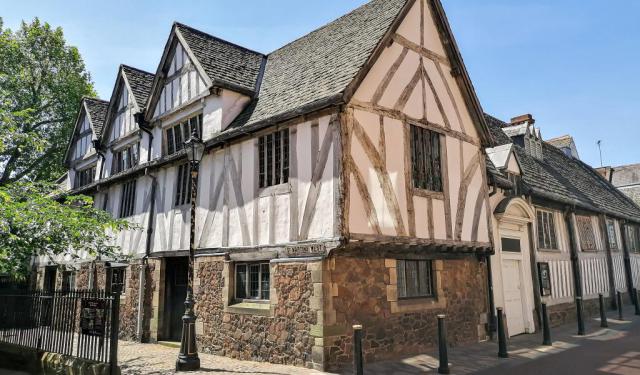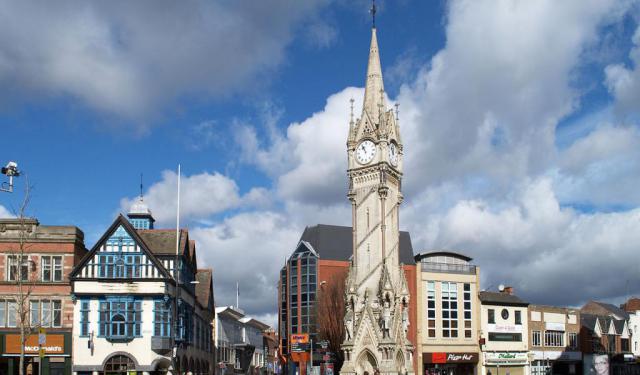
Church of Mary de Castro, Leicester
The Church of Saint Mary de Castro—literally, "Saint Mary of the Castle"—is a historic parish church standing near Leicester Castle. Founded in 1107, its origins trace back to King Henry I, who seized the castle and surrounding lands from a rebellious noble and granted them to Robert de Beaumont. Some legends, however, suggest that a Saxon church dedicated to Saint Mary predated the Norman structure. The church functioned as a collegiate institution until 1548 when Henry VIII dissolved its college.
The earliest version of the church had no aisles, but a major expansion in the 1160s introduced a north aisle, additional doorways, and an extended chancel. The church is well known for its Norman zigzag-decorated doorways, particularly the Sedilia and Piscina, which architectural historian Nikolaus Pevsner praised as the "finest piece of Norman decoration in the county." A 13th-century renovation saw the widening of the south aisle, making it even broader than the nave, and the addition of the large east window with intricate tracery completed around 1300.
The church tower, an architectural afterthought, was built inside the south aisle. It features decorated pinnacles and a quatrefoil frieze, culminating in a needlelike spire. The spire, originally from the 14th century, was rebuilt in 1783 but suffered structural failure in 2013, with six-metre cracks detected in four of its faces. Deemed at risk of collapse, the spire was demolished in 2014, and despite extensive fundraising, there are insufficient funds for its reconstruction.
Inside, the church houses a three-manual pipe organ installed in 1860 by Forster and Andrews. Over time, it underwent modifications by Joshua Porritt (1880) and R. J. Winn (1960). The organ's specification is recorded in the National Pipe Organ Register.
Despite the loss of its iconic spire, Saint Mary de Castro remains an important historic and spiritual landmark in Leicester, reflecting nearly a millennium of architectural evolution and local history.
The earliest version of the church had no aisles, but a major expansion in the 1160s introduced a north aisle, additional doorways, and an extended chancel. The church is well known for its Norman zigzag-decorated doorways, particularly the Sedilia and Piscina, which architectural historian Nikolaus Pevsner praised as the "finest piece of Norman decoration in the county." A 13th-century renovation saw the widening of the south aisle, making it even broader than the nave, and the addition of the large east window with intricate tracery completed around 1300.
The church tower, an architectural afterthought, was built inside the south aisle. It features decorated pinnacles and a quatrefoil frieze, culminating in a needlelike spire. The spire, originally from the 14th century, was rebuilt in 1783 but suffered structural failure in 2013, with six-metre cracks detected in four of its faces. Deemed at risk of collapse, the spire was demolished in 2014, and despite extensive fundraising, there are insufficient funds for its reconstruction.
Inside, the church houses a three-manual pipe organ installed in 1860 by Forster and Andrews. Over time, it underwent modifications by Joshua Porritt (1880) and R. J. Winn (1960). The organ's specification is recorded in the National Pipe Organ Register.
Despite the loss of its iconic spire, Saint Mary de Castro remains an important historic and spiritual landmark in Leicester, reflecting nearly a millennium of architectural evolution and local history.
Want to visit this sight? Check out these Self-Guided Walking Tours in Leicester. Alternatively, you can download the mobile app "GPSmyCity: Walks in 1K+ Cities" from Apple App Store or Google Play Store. The app turns your mobile device to a personal tour guide and it works offline, so no data plan is needed when traveling abroad.
Church of Mary de Castro on Map
Sight Name: Church of Mary de Castro
Sight Location: Leicester, England (See walking tours in Leicester)
Sight Type: Religious
Guide(s) Containing This Sight:
Sight Location: Leicester, England (See walking tours in Leicester)
Sight Type: Religious
Guide(s) Containing This Sight:
Walking Tours in Leicester, England
Create Your Own Walk in Leicester
Creating your own self-guided walk in Leicester is easy and fun. Choose the city attractions that you want to see and a walk route map will be created just for you. You can even set your hotel as the start point of the walk.
Historical Buildings
Leicester, a city in England's East Midlands, has a storied past that is vividly presented in its historical buildings. Valuable architectural monuments, they are the city's pride and as such enjoy special protection by the government.
Among such, Magazine Gateway stands as a testament to the city's medieval legacy. Originally part of its defensive walls, this structure now... view more
Tour Duration: 2 Hour(s)
Travel Distance: 2.6 Km or 1.6 Miles
Among such, Magazine Gateway stands as a testament to the city's medieval legacy. Originally part of its defensive walls, this structure now... view more
Tour Duration: 2 Hour(s)
Travel Distance: 2.6 Km or 1.6 Miles
Leicester Introduction Walking Tour
Leicester is one of the oldest cities in England, whose history goes back almost two millennia. The Romans arrived in the area around 47 AD, during their conquest of southern Britain. Following the Saxon invasion, Leicester was then captured by Danish Vikings, in the 9th century.
The settlement was first documented in the early 10th century, under the name Ligeraceaster. At the time of the... view more
Tour Duration: 1 Hour(s)
Travel Distance: 1.1 Km or 0.7 Miles
The settlement was first documented in the early 10th century, under the name Ligeraceaster. At the time of the... view more
Tour Duration: 1 Hour(s)
Travel Distance: 1.1 Km or 0.7 Miles


